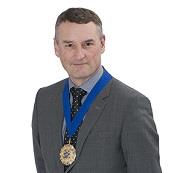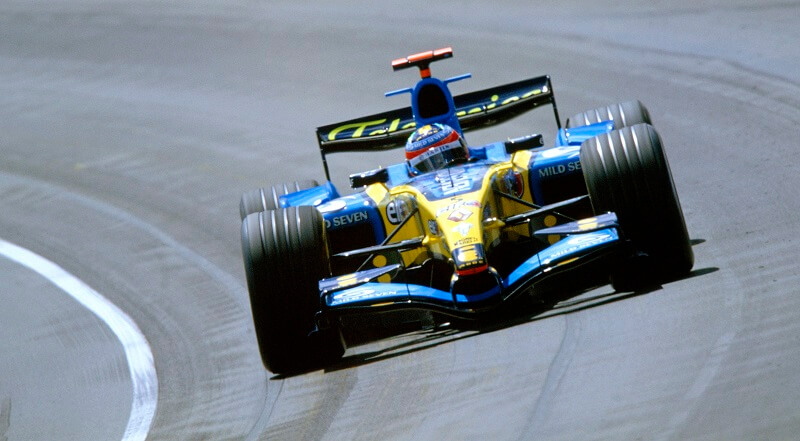Elected President on 25 May, Jon Hilton BSc(Hons) CEng FIMechE has held a number of official posts since he joined the Institution as a young member in 1982. These include serving as a Trustee, Chairman of the Midland Region, Chairman of the Automobile Division and Chairman of the Formula Student organising committee. Download Jon's Presidential Address.
Passionate about engines, he has worked for Rolls-Royce and spent 15 years in the motorsport industry. As Renault F1’s Technical Director - Engine Division, he was intimately involved in the campaign that saw the team win both the drivers’ and constructors’ World Championship titles in 2005 and 2006.
After leaving Formula 1, he formed a new engineering company called Flybrid Automotive to develop high-speed flywheel based hybrid systems for automobile applications.
In his spare time, Jon likes punk rock and working on engines, and is currently restoring an ex-Isle of Man TT Spondon Suzuki racing motorbike.
His first Presidential visit in June will see him strengthen Institution bonds with engineers and engineering organisations in Seattle and Vancouver in North America.
The Institution News team asked Jon some key questions about his hopes and aspirations for the coming year.
 What would you like to achieve as President?
What would you like to achieve as President?
“I’m particularly keen on developing professional engineers, especially through mentoring, and on promoting entrepreneurialism.
“Mentoring can help us get the best out of ourselves. I believe every engineer should have a mentor and at least one mentee. In my opinion, there is enormous scope for increasing the potential of each and every engineer by better mentoring. I even think it improves the career opportunities of the mentor, by making them think more carefully about their own experiences in order to distil the key influences and reinforce the lessons of their own past.
“I also want to highlight the role of entrepreneurs and how well-placed professional engineers are to take up this crucial role. Engineers are essentially problem-solvers and problem-solving is at the heart of entrepreneurialism. We have the chance to create more businesses, more jobs and more great products using our unique set of skills, and I would encourage more engineers to consider this role for themselves.
“As President I also want to focus on continuing our collaboration with other engineering institutions. Whenever we raise the subject we get a strongly supportive message back from the membership, from Council and from all the groups we ask. Federation is what we are aiming at, but there is an intermediary step between where we are now and federation, which involves us collaborating on some of the easy things.
“I think that’s our biggest challenge for the coming year, but I think it’s the right thing to do.”
How has the Institution helped your career?
“I’ve been involved with the Institution for a long time and an active member on one committee or another continuously since 2002. When I was younger I felt I was putting in a reasonable amount of effort, but not getting so much back, but I still felt it was the right thing to do.
“Then when I started my own business in 2007, came out of F1 and moved into a new market space into automotive, I genuinely thought I don’t know anyone in automotive. But it wasn’t true, I realised I knew lots of IMechE people who worked in automotive and actually it’s fair to say that my connections through the Institution opened lots doors that would have been extraordinarily difficult to open any other way. So that network I built up over years while I was working in Formula 1 was vital.
“Also I’ve had the opportunity to do things before I’d been given the chance by my employer. For example, I’d started giving lectures about Formula 1 at age 26 or 27. When I was promoted to management and had to give similar presentations for work, I’d already done half a dozen for the IMechE and I felt a lot more comfortable about it.”
Why did you become an engineer?
“My father was an engineer. He was a de Havilland apprentice and worked on the first passenger jet airliner, the Comet. From a very young age I was very sure that I wanted to be one too, even though my father died when I was a baby. I’ve always loved mechanical things. I took apart lawn mowers and motorbikes at home. There was no way I was going to be anything else.”
What has been your most memorable experience as an engineer?
“In my career I have been lucky to spend more than 15 years working in the motorsport industry. I’ve won five F1 world titles and I’ll never forget when the Renault F1 team won the Drivers’ and Constructors' World Championship in 2005. My wife and I watched the race with the team on the Champs-Élysées and all the guys from the French factory. It was a fantastic experience to watch our car win the race and the title with a huge group of friends and colleagues. I was very lucky to be a part of what had been such a massive team effort."

Who do you admire?
“Throughout my career I have been lucky to have my life touched by many really good engineers and a few really good entrepreneurs. Undoubtedly this shaped how I chose to steer my career. During my Rolls-Royce apprenticeship I met the person who probably shaped my work persona the most. John Favell was the manager of the factory at Leavesden and was known for being a very direct and no-nonsense manager. There could be no indecisiveness and no procrastination on his team. Once he picked up a piece of paper that required action, he would not put it down until the action was complete. In all, I only spent five days as his shadow, going everywhere he went and doing everything he did. He found it impossible to keep up his external act with me, as on the inside he was a really nice guy, and I discovered how useful it can be to have separate personae for work and home.”
What would you like to be remembered for?
“I love to think that I’d inspired a number of other people to try new things and make the most of their own abilities and to create jobs and wealth. I’d be very pleased if I can provide a bit of inspiration to others to follow a similar path to my own. I’m a normal chap who has made the most of their opportunities and would like to see others do that too.”
What’s the greatest challenge facing engineering today?
“The pace of change today is high. When I look back it never ceases to amaze me how much has changed since my grandmother was born in 1901. The change in her lifetime was incredible, but if anything it has stepped up. It’s a tough job to keep up and to look forward enough to envisage what new products might be useful to people in 10-years’ time. The world could be quite a different place by then. Yet, that is what we’re going to have to do if we’re going to invent something completely new because that’s how long it takes to get it to fruition.”
What’s your favourite engineering innovation?
“I’m very impressed with the methodology Apple use to make its devices. The thing that impresses me is their ability make something before you knew you wanted it. It’s rare to see successive steps that have all hit the mark. In the automotive world, where I’ve spent most of my working life, there are not that many examples of proper breakthrough vehicles. Vehicles like the Ford Transit van and the Renault Espace started whole new markets, but this is really hard to do time and time again. Apple’s ability to ‘future cast’ is very impressive."
What else are you passionate about?
“I do quite a lot of sailing and my wife and I have a 51ft yacht on the south coast. I like sailing because it’s quite mathematical and related to engineering in many ways.”
“I’m passionate about racing cars and motorcycles. I used to race cars and am in the process of rebuilding an ex-Isle of Man TT Spondon Suzuki racing motorbike. It’s got a British made Spondon chassis with an 1100cc Japanese Suzuki engine in it. I’m hoping to get that working and take it back to the Isle of Man. Years ago I raced in speed hillclimb and did that for quite a few seasons and competed in sprinting events. I raced in Brighton speed trials and went to the famous hillclimb tracks such as Prescott and Shelsley Walsh in a car I did a lot of engineering work on myself. It was a turbo-charged Suzuki-engined hillclimb car that was very fast going from zero to 141mph in 10.5 seconds.
“I think the Bloodhound project is mind-blowing. It’s a fantastic thing to be attempting to do but there are so many variables to consider. I think it’s a spectacular project.”
To find out more about Jon, read his biography and download his Presidential Address.